MATLAB画图入门篇--各种基本图形绘制的函数与实例
- 格式:pdf
- 大小:177.02 KB
- 文档页数:8

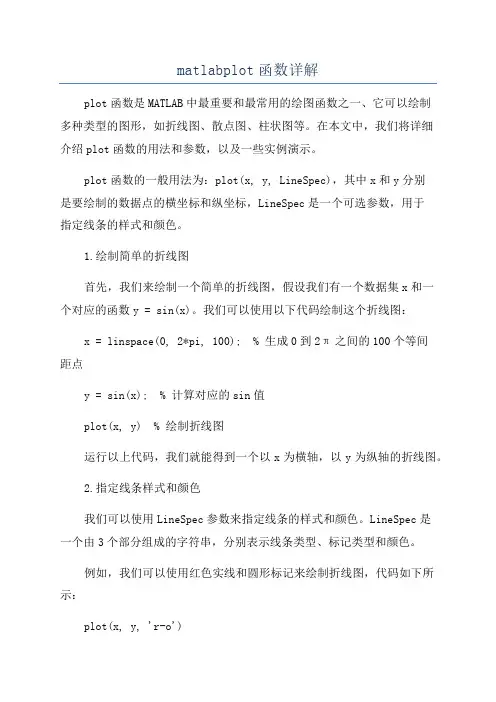
matlabplot函数详解plot函数是MATLAB中最重要和最常用的绘图函数之一、它可以绘制多种类型的图形,如折线图、散点图、柱状图等。
在本文中,我们将详细介绍plot函数的用法和参数,以及一些实例演示。
plot函数的一般用法为:plot(x, y, LineSpec),其中x和y分别是要绘制的数据点的横坐标和纵坐标,LineSpec是一个可选参数,用于指定线条的样式和颜色。
1.绘制简单的折线图首先,我们来绘制一个简单的折线图,假设我们有一个数据集x和一个对应的函数y = sin(x)。
我们可以使用以下代码绘制这个折线图:x = linspace(0, 2*pi, 100); % 生成0到2π之间的100个等间距点y = sin(x); % 计算对应的sin值plot(x, y) % 绘制折线图运行以上代码,我们就能得到一个以x为横轴,以y为纵轴的折线图。
2.指定线条样式和颜色我们可以使用LineSpec参数来指定线条的样式和颜色。
LineSpec是一个由3个部分组成的字符串,分别表示线条类型、标记类型和颜色。
例如,我们可以使用红色实线和圆形标记来绘制折线图,代码如下所示:plot(x, y, 'r-o')其中,'r'表示红色,'-'表示实线,'o'表示圆形标记。
运行以上代码,我们可以得到红色实线和圆形标记的折线图。
3.绘制多条曲线plot函数可以同时绘制多条曲线。
我们只需要将不同的数据点传递给x和y,然后用逗号分隔开即可。
例如,我们可以绘制一个由两条正弦曲线构成的图形,代码如下所示:y1 = sin(x);y2 = sin(2*x);plot(x, y1, x, y2)运行以上代码,我们将得到两条正弦曲线组成的图形。
title('折线图示例')xlabel('x')ylabel('y')5.修改坐标轴范围有时候,我们希望修改坐标轴的范围,以更好地展示数据。
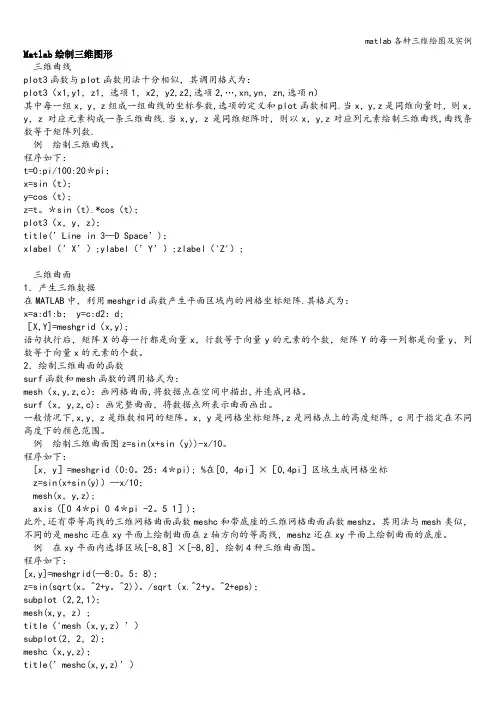
Matlab绘制三维图形三维曲线plot3函数与plot函数用法十分相似,其调用格式为:plot3(x1,y1,z1,选项1,x2,y2,z2,选项2,…,xn,yn,zn,选项n)其中每一组x,y,z组成一组曲线的坐标参数,选项的定义和plot函数相同.当x,y,z是同维向量时,则x,y,z 对应元素构成一条三维曲线.当x,y,z是同维矩阵时,则以x,y,z对应列元素绘制三维曲线,曲线条数等于矩阵列数.例绘制三维曲线。
程序如下:t=0:pi/100:20*pi;x=sin(t);y=cos(t);z=t。
*sin(t).*cos(t);plot3(x,y,z);title(’Line in 3—D Space’);xlabel(’X’);ylabel(’Y’);zlabel('Z');三维曲面1.产生三维数据在MATLAB中,利用meshgrid函数产生平面区域内的网格坐标矩阵.其格式为:x=a:d1:b; y=c:d2:d;[X,Y]=meshgrid(x,y);语句执行后,矩阵X的每一行都是向量x,行数等于向量y的元素的个数,矩阵Y的每一列都是向量y,列数等于向量x的元素的个数。
2.绘制三维曲面的函数surf函数和mesh函数的调用格式为:mesh(x,y,z,c):画网格曲面,将数据点在空间中描出,并连成网格。
surf(x,y,z,c):画完整曲面,将数据点所表示曲面画出。
一般情况下,x,y,z是维数相同的矩阵。
x,y是网格坐标矩阵,z是网格点上的高度矩阵,c用于指定在不同高度下的颜色范围。
例绘制三维曲面图z=sin(x+sin(y))-x/10。
程序如下:[x,y]=meshgrid(0:0。
25:4*pi); %在[0,4pi]×[0,4pi]区域生成网格坐标z=sin(x+sin(y))—x/10;mesh(x,y,z);axis([0 4*pi 0 4*pi -2。
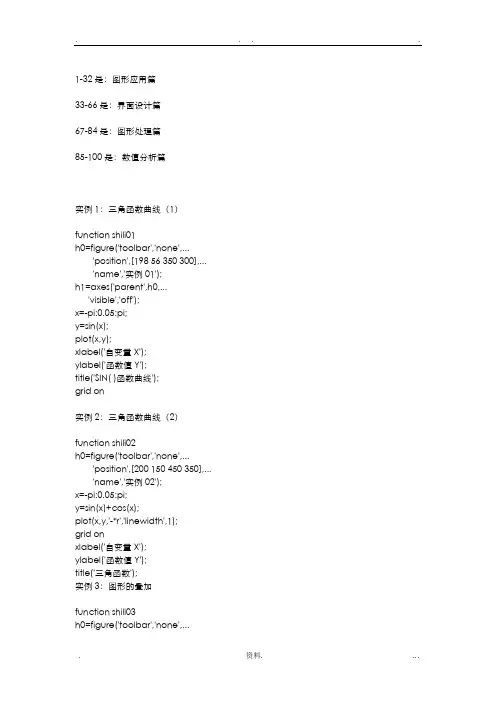
1-32是:图形应用篇33-66是:界面设计篇67-84是:图形处理篇85-100是:数值分析篇实例1:三角函数曲线(1)function shili01h0=figure('toolbar','none',...'position',[198 56 350 300],...'name','实例01');h1=axes('parent',h0,...'visible','off');x=-pi:0.05:pi;y=sin(x);plot(x,y);xlabel('自变量X');ylabel('函数值Y');title('SIN( )函数曲线');grid on实例2:三角函数曲线(2)function shili02h0=figure('toolbar','none',...'position',[200 150 450 350],...'name','实例02');x=-pi:0.05:pi;y=sin(x)+cos(x);plot(x,y,'-*r','linewidth',1);grid onxlabel('自变量X');ylabel('函数值Y');title('三角函数');实例3:图形的叠加function shili03h0=figure('toolbar','none',...'position',[200 150 450 350],...'name','实例03');x=-pi:0.05:pi;y1=sin(x);y2=cos(x);plot(x,y1,...'-*r',...x,y2,...'--og');grid onxlabel('自变量X');ylabel('函数值Y');title('三角函数');实例4:双y轴图形的绘制function shili04h0=figure('toolbar','none',...'position',[200 150 450 250],...'name','实例04');x=0:900;a=1000;b=0.005;y1=2*x;y2=cos(b*x);[haxes,hline1,hline2]=plotyy(x,y1,x,y2,'semilogy','plot'); axes(haxes(1))ylabel('semilog plot');axes(haxes(2))ylabel('linear plot');实例5:单个轴窗口显示多个图形function shili05h0=figure('toolbar','none',...'position',[200 150 450 250],...'name','实例05');t=0:pi/10:2*pi;[x,y]=meshgrid(t);subplot(2,2,1)plot(sin(t),cos(t))axis equalsubplot(2,2,2)z=sin(x)-cos(y);plot(t,z)axis([0 2*pi -2 2])subplot(2,2,3)h=sin(x)+cos(y);plot(t,h)axis([0 2*pi -2 2])subplot(2,2,4)g=(sin(x).^2)-(cos(y).^2);plot(t,g)axis([0 2*pi -1 1])实例6:图形标注function shili06h0=figure('toolbar','none',...'position',[200 150 450 400],...'name','实例06');t=0:pi/10:2*pi;h=plot(t,sin(t));xlabel('t=0到2\pi','fontsize',16);ylabel('sin(t)','fontsize',16);title('\it{从0to2\pi 的正弦曲线}','fontsize',16) x=get(h,'xdata');y=get(h,'ydata');imin=find(min(y)==y);imax=find(max(y)==y);text(x(imin),y(imin),...['\leftarrow最小值=',num2str(y(imin))],...'fontsize',16)text(x(imax),y(imax),...['\leftarrow最大值=',num2str(y(imax))],...'fontsize',16)实例7:条形图形function shili07h0=figure('toolbar','none',...'position',[200 150 450 350],...'name','实例07');tiao1=[562 548 224 545 41 445 745 512];tiao2=[47 48 57 58 54 52 65 48];t=0:7;bar(t,tiao1)xlabel('X轴');ylabel('TIAO1值');h1=gca;h2=axes('position',get(h1,'position'));plot(t,tiao2,'linewidth',3)set(h2,'yaxislocation','right','color','none','xticklabel',[]) 实例8:区域图形function shili08h0=figure('toolbar','none',...'position',[200 150 450 250],...'name','实例08');x=91:95;profits1=[88 75 84 93 77];profits2=[51 64 54 56 68];profits3=[42 54 34 25 24];profits4=[26 38 18 15 4];area(x,profits1,'facecolor',[0.5 0.9 0.6],...'edgecolor','b',...'linewidth',3)hold onarea(x,profits2,'facecolor',[0.9 0.85 0.7],...'edgecolor','y',...'linewidth',3)hold onarea(x,profits3,'facecolor',[0.3 0.6 0.7],...'edgecolor','r',...'linewidth',3)hold onarea(x,profits4,'facecolor',[0.6 0.5 0.9],...'edgecolor','m',...'linewidth',3)hold offset(gca,'xtick',[91:95])set(gca,'layer','top')gtext('\leftarrow第一季度销量')gtext('\leftarrow第二季度销量')gtext('\leftarrow第三季度销量')gtext('\leftarrow第四季度销量')xlabel('年','fontsize',16);ylabel('销售量','fontsize',16);实例9:饼图的绘制function shili09h0=figure('toolbar','none',...'position',[200 150 450 250],...'name','实例09');t=[54 21 35;68 54 35;45 25 12;48 68 45;68 54 69];x=sum(t);h=pie(x);textobjs=findobj(h,'type','text');str1=get(textobjs,{'string'});val1=get(textobjs,{'extent'});oldext=cat(1,val1{:});names={'商品一:';'商品二:';'商品三:'};str2=strcat(names,str1);set(textobjs,{'string'},str2)val2=get(textobjs,{'extent'});newext=cat(1,val2{:});offset=sign(oldext(:,1)).*(newext(:,3)-oldext(:,3))/2; pos=get(textobjs,{'position'});textpos=cat(1,pos{:});textpos(:,1)=textpos(:,1)+offset;set(textobjs,{'position'},num2cell(textpos,[3,2]))实例10:阶梯图function shili10h0=figure('toolbar','none',...'position',[200 150 450 400],...'name','实例10');a=0.01;b=0.5;t=0:10;f=exp(-a*t).*sin(b*t);stairs(t,f)hold onplot(t,f,':*')hold offglabel='函数e^{-(\alpha*t)}sin\beta*t的阶梯图'; gtext(glabel,'fontsize',16)xlabel('t=0:10','fontsize',16)axis([0 10 -1.2 1.2])实例11:枝干图function shili11h0=figure('toolbar','none',...'position',[200 150 450 350],...'name','实例11');x=0:pi/20:2*pi;y1=sin(x);y2=cos(x);h1=stem(x,y1+y2);hold onh2=plot(x,y1,'^r',x,y2,'*g');hold offh3=[h1(1);h2];legend(h3,'y1+y2','y1=sin(x)','y2=cos(x)') xlabel('自变量X');ylabel('函数值Y');title('正弦函数与余弦函数的线性组合');实例12:罗盘图function shili12h0=figure('toolbar','none',...'position',[200 150 450 250],...'name','实例12');winddirection=[54 24 65 84256 12 235 62125 324 34 254];windpower=[2 5 5 36 8 12 76 14 10 8];rdirection=winddirection*pi/180;[x,y]=pol2cart(rdirection,windpower); compass(x,y);desc={'风向和风力','气象台','10月1日0:00到','10月1日12:00'};gtext(desc)实例13:轮廓图function shili13h0=figure('toolbar','none',...'position',[200 150 450 250],...'name','实例13');[th,r]=meshgrid((0:10:360)*pi/180,0:0.05:1); [x,y]=pol2cart(th,r);z=x+i*y;f=(z.^4-1).^(0.25);contour(x,y,abs(f),20)axis equalxlabel('实部','fontsize',16);ylabel('虚部','fontsize',16);h=polar([0 2*pi],[0 1]);delete(h)hold oncontour(x,y,abs(f),20)实例14:交互式图形function shili14h0=figure('toolbar','none',...'position',[200 150 450 250],...'name','实例14');axis([0 10 0 10]);hold onx=[];y=[];n=0;disp('单击鼠标左键点取需要的点'); disp('单击鼠标右键点取最后一个点'); but=1;while but==1[xi,yi,but]=ginput(1);plot(xi,yi,'bo')n=n+1;disp('单击鼠标左键点取下一个点');x(n,1)=xi;y(n,1)=yi;endt=1:n;ts=1:0.1:n;xs=spline(t,x,ts);ys=spline(t,y,ts);plot(xs,ys,'r-');hold off实例14:交互式图形function shili14h0=figure('toolbar','none',...'position',[200 150 450 250],...'name','实例14');axis([0 10 0 10]);hold onx=[];y=[];n=0;disp('单击鼠标左键点取需要的点'); disp('单击鼠标右键点取最后一个点'); but=1;while but==1[xi,yi,but]=ginput(1);plot(xi,yi,'bo')n=n+1;disp('单击鼠标左键点取下一个点');x(n,1)=xi;y(n,1)=yi;endt=1:n;ts=1:0.1:n;xs=spline(t,x,ts);ys=spline(t,y,ts);plot(xs,ys,'r-');hold off实例15:变换的傅立叶函数曲线function shili15h0=figure('toolbar','none',...'position',[200 150 450 250],...'name','实例15');axis equalm=moviein(20,gcf);set(gca,'nextplot','replacechildren') h=uicontrol('style','slider','position',...[100 10 500 20],'min',1,'max',20) for j=1:20plot(fft(eye(j+16)))set(h,'value',j)m(:,j)=getframe(gcf);endclf;axes('position',[0 0 1 1]);movie(m,30)实例16:劳伦兹非线形方程的无序活动function shili15h0=figure('toolbar','none',...'position',[200 150 450 250],...'name','实例15');axis equalm=moviein(20,gcf);set(gca,'nextplot','replacechildren') h=uicontrol('style','slider','position',...[100 10 500 20],'min',1,'max',20) for j=1:20plot(fft(eye(j+16)))set(h,'value',j)m(:,j)=getframe(gcf);endclf;axes('position',[0 0 1 1]);movie(m,30)实例17:填充图function shili17h0=figure('toolbar','none',...'position',[200 150 450 250],...'name','实例17');t=(1:2:15)*pi/8;x=sin(t);y=cos(t);fill(x,y,'r')axis square offtext(0,0,'STOP',...'color',[1 1 1],...'fontsize',50,...'horizontalalignment','center') 例18:条形图和阶梯形图function shili18h0=figure('toolbar','none',...'position',[200 150 450 250],...'name','实例18');subplot(2,2,1)x=-3:0.2:3;y=exp(-x.*x);bar(x,y)title('2-D Bar Chart')subplot(2,2,2)x=-3:0.2:3;y=exp(-x.*x);bar3(x,y,'r')title('3-D Bar Chart')subplot(2,2,3)x=-3:0.2:3;y=exp(-x.*x);stairs(x,y)title('Stair Chart')subplot(2,2,4)x=-3:0.2:3;y=exp(-x.*x);barh(x,y)title('Horizontal Bar Chart')实例19:三维曲线图function shili19h0=figure('toolbar','none',...'position',[200 150 450 400],...'name','实例19');subplot(2,1,1)x=linspace(0,2*pi);y1=sin(x);y2=cos(x);y3=sin(x)+cos(x);z1=zeros(size(x));z2=0.5*z1;z3=z1;plot3(x,y1,z1,x,y2,z2,x,y3,z3)grid onxlabel('X轴');ylabel('Y轴');zlabel('Z轴');title('Figure1:3-D Plot')subplot(2,1,2)x=linspace(0,2*pi);y1=sin(x);y2=cos(x);y3=sin(x)+cos(x);z1=zeros(size(x));z2=0.5*z1;z3=z1;plot3(x,z1,y1,x,z2,y2,x,z3,y3)grid onxlabel('X轴');ylabel('Y轴');zlabel('Z轴');title('Figure2:3-D Plot')实例20:图形的隐藏属性function shili20h0=figure('toolbar','none',...'position',[200 150 450 300],...'name','实例20');subplot(1,2,1)[x,y,z]=sphere(10);mesh(x,y,z)axis offtitle('Figure1:Opaque')hidden onsubplot(1,2,2)[x,y,z]=sphere(10);mesh(x,y,z)axis offtitle('Figure2:Transparent') hidden off实例21PEAKS函数曲线function shili21h0=figure('toolbar','none',...'position',[200 100 450 450],...'name','实例21');[x,y,z]=peaks(30);subplot(2,1,1)x=x(1,:);y=y(:,1);i=find(y>0.8&y<1.2);j=find(x>-0.6&x<0.5);z(i,j)=nan*z(i,j);surfc(x,y,z)xlabel('X轴');ylabel('Y轴');zlabel('Z轴');title('Figure1:surfc函数形成的曲面') subplot(2,1,2)x=x(1,:);y=y(:,1);i=find(y>0.8&y<1.2);j=find(x>-0.6&x<0.5);z(i,j)=nan*z(i,j);surfl(x,y,z)xlabel('X轴');ylabel('Y轴');zlabel('Z轴');title('Figure2:surfl函数形成的曲面')实例22:片状图function shili22h0=figure('toolbar','none',...'position',[200 150 550 350],...'name','实例22');subplot(1,2,1)x=rand(1,20);y=rand(1,20);z=peaks(x,y*pi);t=delaunay(x,y);trimesh(t,x,y,z)hidden offtitle('Figure1:Triangular Surface Plot'); subplot(1,2,2)x=rand(1,20);y=rand(1,20);z=peaks(x,y*pi);t=delaunay(x,y);trisurf(t,x,y,z)title('Figure1:Triangular Surface Plot'); 实例23:视角的调整function shili23h0=figure('toolbar','none',...'position',[200 150 450 350],...'name','实例23');x=-5:0.5:5;[x,y]=meshgrid(x);r=sqrt(x.^2+y.^2)+eps;z=sin(r)./r;subplot(2,2,1)surf(x,y,z)xlabel('X-axis')ylabel('Y-axis')zlabel('Z-axis')title('Figure1')view(-37.5,30)subplot(2,2,2)surf(x,y,z)xlabel('X-axis')ylabel('Y-axis')zlabel('Z-axis')title('Figure2')view(-37.5+90,30)subplot(2,2,3)surf(x,y,z)xlabel('X-axis')ylabel('Y-axis')zlabel('Z-axis')title('Figure3')view(-37.5,60)subplot(2,2,4)surf(x,y,z)xlabel('X-axis')ylabel('Y-axis')zlabel('Z-axis')title('Figure4')view(180,0)实例24:向量场的绘制function shili24h0=figure('toolbar','none',...'position',[200 150 450 350],...'name','实例24');subplot(2,2,1)z=peaks;ribbon(z)title('Figure1')subplot(2,2,2)[x,y,z]=peaks(15);[dx,dy]=gradient(z,0.5,0.5); contour(x,y,z,10)hold onquiver(x,y,dx,dy)hold offtitle('Figure2')subplot(2,2,3)[x,y,z]=peaks(15);[nx,ny,nz]=surfnorm(x,y,z);surf(x,y,z)hold onquiver3(x,y,z,nx,ny,nz)hold offtitle('Figure3')subplot(2,2,4)x=rand(3,5);y=rand(3,5);z=rand(3,5);c=rand(3,5);fill3(x,y,z,c)grid ontitle('Figure4')实例25:灯光定位function shili25h0=figure('toolbar','none',...'position',[200 150 450 250],...'name','实例25');vert=[1 1 1;1 2 1;2 2 1;2 1 1;1 1 2;12 2;2 2 2;2 1 2];fac=[1 2 3 4;2 6 7 3;4 3 7 8;15 8 4;1 2 6 5;5 6 7 8];grid offsphere(36)h=findobj('type','surface');set(h,'facelighting','phong',...'facecolor',...'interp',...'edgecolor',[0.4 0.4 0.4],...'backfacelighting',...'lit')hold onpatch('faces',fac,'vertices',vert,...'facecolor','y');light('position',[1 3 2]);light('position',[-3 -1 3]); material shinyaxis vis3d offhold off实例26:柱状图function shili26h0=figure('toolbar','none',...'position',[200 50 450 450],...'name','实例26');subplot(2,1,1)x=[5 2 18 7 39 8 65 5 54 3 2];bar(x)xlabel('X轴');ylabel('Y轴');title('第一子图');subplot(2,1,2)y=[5 2 18 7 39 8 65 5 54 3 2];barh(y)xlabel('X轴');ylabel('Y轴');title('第二子图');实例27:设置照明方式function shili27h0=figure('toolbar','none',...'position',[200 150 450 350],...'name','实例27');subplot(2,2,1)sphereshading flatcamlight leftcamlight rightlighting flatcolorbaraxis offtitle('Figure1')subplot(2,2,2)sphereshading flatcamlight leftcamlight rightlighting gouraudcolorbaraxis offtitle('Figure2')subplot(2,2,3)sphereshading interpcamlight rightcamlight leftlighting phongcolorbaraxis offtitle('Figure3')subplot(2,2,4)sphereshading flatcamlight leftcamlight rightlighting nonecolorbaraxis offtitle('Figure4')实例28:羽状图function shili28h0=figure('toolbar','none',...'position',[200 150 450 350],...'name','实例28');subplot(2,1,1)alpha=90:-10:0;r=ones(size(alpha));m=alpha*pi/180;n=r*10;[u,v]=pol2cart(m,n);feather(u,v)title('羽状图')axis([0 20 0 10])subplot(2,1,2)t=0:0.5:10;x=0.05+i;y=exp(-x*t);feather(y)title('复数矩阵的羽状图')实例29:立体透视(1)function shili29h0=figure('toolbar','none',...'position',[200 150 450 250],...'name','实例29');[x,y,z]=meshgrid(-2:0.1:2,...-2:0.1:2,...-2:0.1:2);v=x.*exp(-x.^2-y.^2-z.^2);grid onfor i=-2:0.5:2;h1=surf(linspace(-2,2,20),...linspace(-2,2,20),...zeros(20)+i);rotate(h1,[1 -1 1],30)dx=get(h1,'xdata');dy=get(h1,'ydata');dz=get(h1,'zdata');delete(h1)slice(x,y,z,v,[-2 2],2,-2)hold onslice(x,y,z,v,dx,dy,dz)hold offaxis tightview(-5,10)drawnowend实例30:立体透视(2)function shili30h0=figure('toolbar','none',...'position',[200 150 450 250],...'name','实例30');[x,y,z]=meshgrid(-2:0.1:2,...-2:0.1:2,...-2:0.1:2);v=x.*exp(-x.^2-y.^2-z.^2); [dx,dy,dz]=cylinder;slice(x,y,z,v,[-2 2],2,-2)for i=-2:0.2:2h=surface(dx+i,dy,dz);rotate(h,[1 0 0],90)xp=get(h,'xdata');yp=get(h,'ydata');zp=get(h,'zdata');delete(h)hold onhs=slice(x,y,z,v,xp,yp,zp);axis tightxlim([-3 3])view(-10,35)drawnowdelete(hs)hold offend实例31:表面图形function shili31h0=figure('toolbar','none',...'position',[200 150 550 250],...'name','实例31');subplot(1,2,1)x=rand(100,1)*16-8;y=rand(100,1)*16-8;r=sqrt(x.^2+y.^2)+eps;z=sin(r)./r;xlin=linspace(min(x),max(x),33); ylin=linspace(min(y),max(y),33); [X,Y]=meshgrid(xlin,ylin);Z=griddata(x,y,z,X,Y,'cubic'); mesh(X,Y,Z)axis tighthold onplot3(x,y,z,'.','Markersize',20)subplot(1,2,2)k=5;n=2^k-1;theta=pi*(-n:2:n)/n;phi=(pi/2)*(-n:2:n)'/n;X=cos(phi)*cos(theta);Y=cos(phi)*sin(theta);Z=sin(phi)*ones(size(theta));colormap([0 0 0;1 1 1])C=hadamard(2^k);surf(X,Y,Z,C)axis square实例32:沿曲线移动的小球h0=figure('toolbar','none',...'position',[198 56 408 468],...'name','实例32');h1=axes('parent',h0,...'position',[0.15 0.45 0.7 0.5],...'visible','on');t=0:pi/24:4*pi;y=sin(t);plot(t,y,'b')n=length(t);h=line('color',[0 0.5 0.5],...'linestyle','.',...'markersize',25,...'erasemode','xor');k1=uicontrol('parent',h0,...'style','pushbutton',...'position',[80 100 50 30],...'string','开始',...'callback',[...'i=1;',...'k=1;,',...'m=0;,',...'while 1,',...'if k==0,',...'break,',...'end,',...'if k~=0,',...'set(h,''xdata'',t(i),''ydata'',y(i)),',...'drawnow;,',...'i=i+1;,',...'if i>n,',...'m=m+1;,',...'i=1;,',...'end,',...'end,',...'end']);k2=uicontrol('parent',h0,...'style','pushbutton',...'position',[180 100 50 30],...'string','停止',...'callback',[...'k=0;,',...'set(e1,''string'',m),',...'p=get(h,''xdata'');,',...'q=get(h,''ydata'');,',...'set(e2,''string'',p);,',...'set(e3,''string'',q)']); k3=uicontrol('parent',h0,...'style','pushbutton',...'position',[280 100 50 30],...'string','关闭',...'callback','close');e1=uicontrol('parent',h0,...'style','edit',...'position',[60 30 60 20]);t1=uicontrol('parent',h0,...'style','text',...'string','循环次数',...'position',[60 50 60 20]);e2=uicontrol('parent',h0,...'style','edit',...'position',[180 30 50 20]); t2=uicontrol('parent',h0,...'style','text',...'string','终点的X坐标值',...'position',[155 50 100 20]); e3=uicontrol('parent',h0,...'style','edit',...'position',[300 30 50 20]); t3=uicontrol('parent',h0,...'style','text',...'string','终点的Y坐标值',...'position',[275 50 100 20]);实例33:曲线转换按钮h0=figure('toolbar','none',...'position',[200 150 450 250],...'name','实例33');x=0:0.5:2*pi;y=sin(x);h=plot(x,y);grid onhuidiao=[...'if i==1,',...'i=0;,',...'y=cos(x);,',...'delete(h),',...'set(hm,''string'',''正弦函数''),',...'h=plot(x,y);,',...'grid on,',...'else if i==0,',...'i=1;,',...'y=sin(x);,',...'set(hm,''string'',''余弦函数''),',...'delete(h),',...'h=plot(x,y);,',...'grid on,',...'end,',...'end'];hm=uicontrol(gcf,'style','pushbutton',...'string','余弦函数',...'callback',huidiao);i=1;set(hm,'position',[250 20 60 20]);set(gca,'position',[0.2 0.2 0.6 0.6])title('按钮的使用')hold on实例34:栅格控制按钮h0=figure('toolbar','none',...'position',[200 150 450 250],...'name','实例34');x=0:0.5:2*pi;y=sin(x);plot(x,y)huidiao1=[...'set(h_toggle2,''value'',0),',...'grid on,',...];huidiao2=[...'set(h_toggle1,''value'',0),',...'grid off,',...];h_toggle1=uicontrol(gcf,'style','togglebutton',...'string','grid on',...'value',0,...'position',[20 45 50 20],...'callback',huidiao1);h_toggle2=uicontrol(gcf,'style','togglebutton',...'string','grid off',...'value',0,...'position',[20 20 50 20],...'callback',huidiao2);set(gca,'position',[0.2 0.2 0.6 0.6])title('开关按钮的使用')实例35:编辑框的使用h0=figure('toolbar','none',...'position',[200 150 350 250],...'name','实例35');f='Please input the letter';huidiao1=[...'g=upper(f);,',...'set(h2_edit,''string'',g),',...];huidiao2=[...'g=lower(f);,',...'set(h2_edit,''string'',g),',...];h1_edit=uicontrol(gcf,'style','edit',...'position',[100 200 100 50],...'HorizontalAlignment','left',...'string','Please input the letter',...'callback','f=get(h1_edit,''string'');',...'background','w',...'max',5,...'min',1);h2_edit=uicontrol(gcf,'style','edit',...'HorizontalAlignment','left',...'position',[100 100 100 50],...'max',5,...'min',1);h1_button=uicontrol(gcf,'style','pushbutton',...'string','小写变大写',...'position',[100 45 100 20],...'callback',huidiao1);h2_button=uicontrol(gcf,'style','pushbutton',...'string','大写变小写',...'position',[100 20 100 20],...'callback',huidiao2);实例36:弹出式菜单h0=figure('toolbar','none',...'position',[200 150 450 250],...'name','实例36');x=0:0.5:2*pi;y=sin(x);h=plot(x,y);grid onhm=uicontrol(gcf,'style','popupmenu',...'string',...'sin(x)|cos(x)|sin(x)+cos(x)|exp(-sin(x))',...'position',[250 20 50 20]);set(hm,'value',1)huidiao=[...'v=get(hm,''value'');,',...'switch v,',...'case 1,',...'delete(h),',...'y=sin(x);,',...'h=plot(x,y);,',...'grid on,',...'case 2,',...'delete(h),',...'y=cos(x);,',...'h=plot(x,y);,',...'grid on,',...'case 3,',...'delete(h),',...'y=sin(x)+cos(x);,',...'h=plot(x,y);,',...'grid on,',...'case 4,',...'y=exp(-sin(x));,',...'h=plot(x,y);,',...'grid on,',...'end'];set(hm,'callback',huidiao)set(gca,'position',[0.2 0.2 0.6 0.6])title('弹出式菜单的使用')实例37:滑标的使用h0=figure('toolbar','none',...'position',[200 150 450 250],...'name','实例37');[x,y]=meshgrid(-8:0.5:8);r=sqrt(x.^2+y.^2)+eps;z=sin(r)./r;h0=mesh(x,y,z);h1=axes('position',...[0.2 0.2 0.5 0.5],...'visible','off');htext=uicontrol(gcf,...'units','points',...'position',[20 30 45 15],...'string','brightness',...'style','text');hslider=uicontrol(gcf,...'units','points',...'position',[10 10 300 15],...'min',-1,...'max',1,...'style','slider',...'callback',...'brighten(get(hslider,''value''))');实例38:多选菜单h0=figure('toolbar','none',...'position',[200 150 450 250],...'name','实例38');[x,y]=meshgrid(-8:0.5:8);r=sqrt(x.^2+y.^2)+eps;z=sin(r)./r;h0=mesh(x,y,z);hlist=uicontrol(gcf,'style','listbox',...'string','default|spring|summer|autumn|winter',...'max',5,...'min',1,...'position',[20 20 80 100],...'callback',[...'k=get(hlist,''value'');,',...'switch k,',...'case 1,',...'colormap default,',...'case 2,',...'colormap spring,',...'case 3,',...'colormap summer,',...'case 4,',...'colormap autumn,',...'case 5,',...'colormap winter,',...'end']);实例39:菜单控制的使用h0=figure('toolbar','none',...'position',[200 150 450 250],...'name','实例39');x=0:0.5:2*pi;y=cos(x);h=plot(x,y);grid onset(gcf,'toolbar','none')hm=uimenu('label','example');huidiao1=[...'set(hm_gridon,''checked'',''on''),',...'set(hm_gridoff,''checked'',''off''),',...'grid on'];huidiao2=[...'set(hm_gridoff,''checked'',''on''),',...'set(hm_gridon,''checked'',''off''),',...'grid off'];hm_gridon=uimenu(hm,'label','grid on',...'checked','on',...'callback',huidiao1);hm_gridoff=uimenu(hm,'label','grid off',...'checked','off',...'callback',huidiao2);实例40:UIMENU菜单的应用。

MATLAB程序设计作业陈杰杰2013090302072014-11-3MATLAB具有强大的图形处理功能。
下面给出了3个m脚本文件,请在MA TLAB环境下运行,观察其输出。
要求根据每个m文件输出的图形(共18个),用中文翻译并解释产生每个输出图形的函数具体是什么?其功能是什么?文件1:clear all %清除工作区间所有的变量clf %清除图形窗口的内容mfilename('fullpath') %返回当前正在运行的函数所在文件的文件名(全部路径)echo on %显示M文件执行的每一条命令subplot(2,3,1) %使(2*3)幅子图中第一个子图成为当前图t = 0:0.1:10; %将以0为起点、以10为终点、以0.1为步长的一维矩阵赋值给t z = impulse(1, [1 1 1], t); %动力系统的脉冲响应数据,以时间t步长0.1为单位stairs(t(1:5:end),z(1:5:end)) %绘制阶梯状图,从第1行开始,间隔5行取1行,到最后1行为止hold on %保持当前坐标轴和图形,并接受下一次绘制plot(t,z,'r') %用红线绘制横轴为t、纵轴为z的二维函数图plot([0 t(end)], [0 0], 'k:') %用黑色虚线绘制函数图像,要求经过原点平行于横轴、取值范围为0到t的最后一个值title('Impulse Response - (STAIRS)') %将此图命名为Impulse Response - (STAIRS)(脉冲响应-(阶梯图))subplot(2,3,2) %使(2*3)幅子图中第二个子图成为当前图theta = 2*pi*(0:74)/75; %将以0为起点、以2*pi*74/75为终点、2*pi/75为步长的一维矩阵赋值给thetax = cos(theta); %计算cos(theta)的值,并赋给xy = sin(theta); %计算sin(theta)的值,并赋给yz = abs(fft(ones(10,1), 75))'; %ones(10,1)生成十行一列的全一矩阵;fft(ones(10,1), 75)进行快速傅里叶变换;z = abs(fft(ones(10,1), 75))'取幅值并转置stem3(x, y, z) %绘制三维杆状图title('Polar FFT - (STEM3)') %将此图命名为Polar FFT - (STEM3)(极坐标下快速傅里叶变换-(三维针状图))subplot(2,3,3) %使(2*3)幅子图中第二个子图成为当前图[X,Y,Z] = peaks(-2:0.25:2); %产生-2为起点、2为终点、0.25为步长的guassian分布矩阵,返回峰函数的三个坐标轴空间上的数值,X表示在x轴,Y表示在y轴,Z表示在z轴,这样每个点就对应一个(X,Y,)[U,V] = gradient(Z, 0.25); %返回二维数值梯度的U、V部分,这里的0.25指定了沿着梯度的方向取点的间隔为0.25contour(X,Y,Z,10); %绘制矩阵Z的等高线,绘制的等高线被限定在由X、Y指定的区域内,等高线条数为10hold on %保持当前坐标轴和图形,并接受下一次绘制quiver(X,Y,U,V); %使用箭头来直观的显示矢量场,该调用格式表示通过在(X, Y)指定的位置绘制小箭头来表示以该点为起点的向量(U,V)title('Surface Gradient - (CONTOUR & QUIVER)') %将此图命名为Surface Gradient - (CONTOUR & QUIVER)(表面梯度-(等高线图和矢量场图))theta = 0:0.1:4*pi; %将以0为起点、以4*pi为终点、0.1为步长的一维矩阵赋值给theta[x,y] = pol2cart(theta(1:5:end), theta(1:5:end)); %把极坐标(theta(1:5:end), theta(1:5:end))转换为对应的二维笛卡尔坐标(x,y),theta(1:5:end)表示从第一行到最后一行,每五行取一行subplot(2,3,4) %使(2*3)幅子图中第四个子图成为当前图polar(theta,theta) %绘制极坐标图像,第一个theta是用弧度制表示的角度,第二个theta是对应的半径axis([-13 13 -12.5 14.5]) %横坐标范围为-13到13,纵坐标范围为-12.5到14.5title('Spiral Plot - (POLAR)') %将此图命名为Spiral Plot - (POLAR)(螺旋图-极坐标图)subplot(2,3,5) %使(2*3)幅子图中第五个子图成为当前图compass(x,y) %绘制罗盘图axis([-13 13 -12.5 14.5]) %横坐标范围为-13到13,纵坐标范围为-12.5到14.5title('Direction Vectors - (COMPASS)') %将此图命名为Direction Vectors - (COMPASS)(方向矢量-罗盘图)subplot(2,3,6) %使(2*3)幅子图中第六个子图成为当前图feather(x(1:19),y(1:19)) %绘制羽状图,其中x、y表示一组向量,x是向量的横坐标(x分量),y是向量的纵坐标(y分量)。
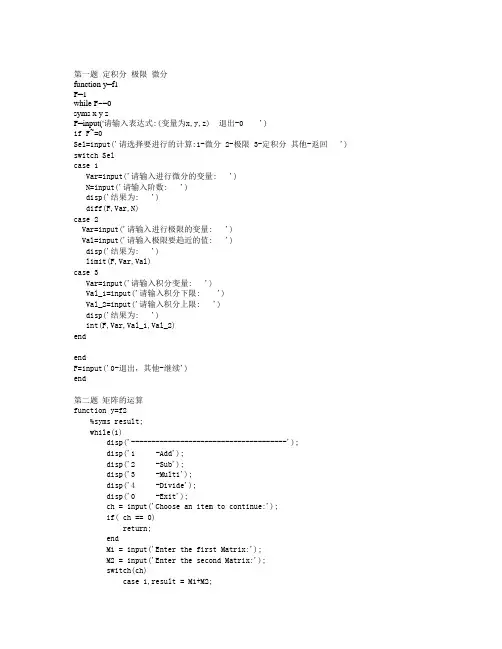
第一题定积分极限微分function y=f1F=1while F~=0syms x y zF=input('请输入表达式:(变量为x,y,z) 退出-0 ')if F~=0Sel=input('请选择要进行的计算:1-微分 2-极限 3-定积分其他-返回 ') switch Selcase 1Var=input('请输入进行微分的变量: ')N=input('请输入阶数: ')disp('结果为: ')diff(F,Var,N)case 2Var=input('请输入进行极限的变量: ')Val=input('请输入极限要趋近的值: ')disp('结果为: ')limit(F,Var,Val)case 3Var=input('请输入积分变量: ')Val_1=input('请输入积分下限: ')Val_2=input('请输入积分上限: ')disp('结果为: ')int(F,Var,Val_1,Val_2)endendF=input('0-退出,其他-继续')end第二题矩阵的运算function y=f2%syms result;while(1)disp('--------------------------------------');disp('1 -Add');disp('2 -Sub');disp('3 -Multi');disp('4 -Divide');disp('0 -Exit');ch = input('Choose an item to continue:');if( ch == 0)return;endM1 = input('Enter the first Matrix:');M2 = input('Enter the second Matrix:');switch(ch)case 1,result = M1+M2;case 2,result = M1-M2;case 3,result = M1*M2;case 4,result = M1/M2;enddisp('The result is :');disp(result);end%End function第三题矩阵的操作function y=f3while(1)disp('--------------------------------------');disp('1 -转置');disp('2 -求秩');disp('3 -求逆');disp('4 -行列式');disp('0 -Exit');ch = input('Choose an item to continue:');if( ch == 0)return;endM = input('Enter the Matrix:');switch(ch)case 1,result = M';case 2,result = rank(M);case 3,result = inv(M);case 4,result = det(M);enddisp('The transform result is :');disp(result);end%End functionendendend第四题向量的判定function y=f4(vec_1,vec_2,dem_1)vec_1=input('第一个向量:')vec_2=input('第二个向量:')Sel_2=input('选择: 1-判断两向量是否共线 2-判断三向量是否共面') if Sel_2==1A=[vec_1;vec_2]if rank(A)==1disp('两向量共线!')elsedisp('两向量不共线!')endelse if Sel_2==2vec_3=input('请输入第三个向量:')dem_3=length(vec_3)if dem_3==dem_1if cro(vec_1,vec_2)*vec_3'==0disp('三向量共面!')elsedisp('三向量不共面!')endelsedisp('输入向量维数不一致!')endendend第五题向量的长度,方向角的计算点积叉积混合积及投影的计算function y=f5n=1while n~=0vec_1=input('请输入第一个向量:')dem_1=length(vec_1)Sel=input('请选择:1-计算向量的方向角,长度 2-计算向量其他运算其他-返回')if Sel==2vec_2=input('请输入第二个向量:')dem_2=length(vec_2)if dem_1==dem_2Sel_1=input('请选择运算:1-点积 2-向量积(三维) 3-投影(三维) 4-混合积(三维) 5-判断共线,共面')switch Sel_1case 5JUDGE(vec_1,vec_2,dem_1)case 1vec_1*vec_2'case 2PAN(vec_1,vec_2)case 3vec_1*vec_2'./sqrt(vec_2*vec_2')case 4vec_3=input('请输入第三个向量(三维):')dem_3=length(vec_3)if dem_3==dem_1A=PAN(vec_1,vec_2)*vec_3'else disp('维数不一致!')endendelsedisp('输入错误!')endelseif Sel==1disp('模为:')Mol=sqrt(vec_1*vec_1')A=eye(dem_1)m=1while m~=dem_1+1acos(A(m,:)*vec_1'./(sqrt(A(m,:)*A(m,:)')*Mol))*180/pim=m+1endelsen=0endendSel=input('继续计算向量的长度、方向角的计算','向量的点积、叉积、混合积及投影-1,退出-2: ')if Sel==2n=0endend第六题点到直线,平面的距离的计算function y=f6n=1while n~=0Point=input('请输入一个三维点坐标向量:')Sel=input('请选择: 1-点到直线的距离 2-点到面的距离 ')switch Selcase 1LinVec=input('请输入直线方程的方向向量:(三维)')LinPot=input('请输入直线方程所经过的点:(三维)')if length(LinVec)==length(LinPot) & length(LinVec)==length(Point)A=p(LinVec,LinPot-Point)disp('点到直线的距离为:')A*A'./(LinVec*LinVec')else disp('输入数值是非法数值!确认后请重新输入!')endPoint=input('1-继续 2-退出')if Point==2n=0endcase 2PlantVec=input('请输入平面法向量:')PlantPot=input('请输入平面上任意一点:')if length(PlantVec)==length(PlantPot) & length(PlantVec)==length(Point)disp('点到平面的距离为:')[PlantPot-Point]*PlantVec'./(PlantVec*PlantVec')disp('输入数值是非法数值!确认后请重新输入!') end endend第七题 椭圆球 function y=pic1 a = 10; b = 20; c = 10;[x,y] = meshgrid(-2:0.1:2,-2:0.1:2);xa = x.^2/a^2; yb = y.^2/b^2;xyz = (ones(size(x))-xa-yb)*c^2; z = xyz.^0.5; mesh(x,y,z);第八题 双曲抛物面 function []=pic2 a = 5; b = 5;[x,y] = meshgrid(-2:0.1:2,-2:0.1:2);xa = x.^2/a^2; yb = y.^2/b^2; z = yb-xa; mesh(x,y,z);第九题 椭圆抛物面 function y=pic3 a = 2; b = 2;[x,y] = meshgrid(-2:0.1:2,-2:0.1:2);xa = x.^2/a^2; yb = y.^2/b^2; z = xa+yb; mesh(x,y,z);第十题 单页双曲面 function y=pic4 theta=0:pi/20:2*pi rho=1:0.05:3[theta,rho]=meshgrid(theta,rho) r=sqrt(rho.^2-1)[x,y,z]=pol2cart(theta,rho,r)figure(1)hold on z=-zsurf(x,y,z) axis off第十一题 双叶双曲面 function k=pic5t1=[-2*pi:0.05:2*pi]; t2=[-1*pi:0.05:1*pi];[t1,t2]=meshgrid(-2*pi:0.05:2*pi,-1*pi:0.05:1*pi); z=0.2*sqrt(sin(t2).*sin(t2)+1);h1=mesh(2*cos(t1).*sin(t2),sin(t1).*sin(t2),z);hold onh2=mesh(2*cos(t1).*sin(t2),sin(t1).*sin(t2),-z);第十二题椭圆锥面function k=tupian4(x,y)x=[-3:0.01:3];y=[-2:0.01:2];[x,y]=meshgrid(-3:0.01:3,-2:0.01:2); z=sqrt((x/3).^2+(y/2).^2); mesh(x,y,z); hold onmesh(x,y,-z);第十三题 常见二维图形theta=0:0.1:2*pi figure(1) rho=2*thetapolar(theta,rho) title('r=at')t=-2*pi:0.1:2*pi figure(1)x=2*(t-sin(t)) y=2*(1-cos(t)) plot(x,y,'g') xlabel('x') ylabel('y') title('摆线')theta=0:0.1:10*pi figure(1)rho=sqrt(4*sin(2*theta)) polar(theta,rho,'g') hold on rho=-rhopolar(theta,rho,'g')legend('r^2=a^2sin2t',2) hold onrho=sqrt(4*cos(2*theta)) polar(theta,rho,'r') hold on rho=-rhopolar(theta,rho,'r')legend('r^2=a^2cos2t',2)theta=0:0.1:4*pi figure(1)rho=exp(0.2*theta) polar(theta,rho) title('r=exp(at)')x=-5:0.1:5y=(1/sqrt((2*pi)))*exp(-x.^2./2) figure(1)plot(x,y,'g') xlabel('x') ylabel('y')title('概率曲线 ')t=0:0.1:2*pi figure(1)x=2*(cos(t)).^3 y=2*(sin(t)).^3 plot(x,y,'g') xlabel('x') ylabel('y')title('x^2/3+y^2/3=a^2/3')theta=0:0.1:2*pi figure(1)rho=2*cos(3*theta) polar(theta,rho,'g')legend('r=asin3t',4)hold onrho=2*sin(3*theta) polar(theta,rho,'r')legend('r=acos3t')theta=0:0.1:2*pi figure(1)rho=2*cos(2*theta) polar(theta,rho,'g') legend('r=acos2t',4)t=0:0.1:2*pi figure(1) x=2*cos(t) y=2*sin(t) plot(x,y,'g') xlabel('x') ylabel('y')title('x^2/a^2+y^2/b^2=1')theta=0:0.1:2*pi figure(1)rho=2*(1-cos(theta)) polar(theta,rho)title('r=a(1-cos(t))')x=-1:(1/20):1 figure(1)subplot(2,2,1) y=asin(x)plot(x,y,'g') title('asin(x)') axis([-1 1 -2 2])subplot(2,2,2) y=acos(x)plot(x,y,'g') title('acos(x)') axis([-1 1 0 4])subplot(2,2,3)y=atan(x)plot(x,y,'g') title('atan(x)') hold on y=y+piplot(x,y,'--') hold on y=y-2*piplot(x,y,'--')axis([-1.5 1.5 -4 4])subplot(2,2,4) y=atan(x)plot(x,y,'g') title('acot(x)') x=-xy=y+pi/2plot(x,y,'--') hold on y=y+piplot(x,y,'--') hold on y=y-2*piplot(x,y,'--')axis([-1.5 1.5 -pi 2*pi])x=-5:0.1:5y=8*2.^3./(x.^2+4*2.^2) figure(1)plot(x,y,'g') hold on x=-2:0.1:2y=sqrt(4-x.^2)+2 plot(x,y,'r') hold ony=-sqrt(4-x.^2)+2 plot(x,y,'r')xlabel('x') ylabel('y')title('y=8a^3/(x^2+4a^2)')y=-5:0.1:5 figure(1)x=(2*(1+y.^2)).^(0.5)plot(x,y,'g')hold onx=-xplot(x,y,'g') xlabel('x') ylabel('y')title('x^2/a^2-y^2/b^2=1')x=-2:0.1:2 figure(1)subplot(2,4,1) y=x.^2plot(x,y,'g') title('x^2')subplot(2,4,2) y=x.^3plot(x,y,'g') title('x^3')subplot(2,4,3) y=x.^(-1)plot(x,y,'g') title('1/x')subplot(2,4,4) x=0:0.1:2 y=x.^0.5plot(x,y,'g')title('x^(1/2)') subplot(2,4,5) x=-2:0.1:2y=(x.^2).^(1/3) plot(x,y,'g') title('x^(2/3)')subplot(2,4,6) x=0:0.1:2 y=x.^(1/3) plot(x,y,'g') hold on x=-x y=-yplot(x,y,'g') title('x^(1/3)')subplot(2,4,7)x=0:0.1:2plot(x,y,'g')hold ony=-yplot(x,y,'g')title('x^(1/3)')x=-4*pi:(pi/20):4*pifigure(1)subplot(2,2,1)y=sin(x)plot(x,y,'g')title('sin(x)')subplot(2,2,2)y=cos(x)plot(x,y,'g')title('cos(x)')subplot(2,2,3)x=-(pi/2-0.0001):pi/20:(pi/2-0.0001)y=tan(x)plot(x,y,'g')title('tan(x)')hold onx=x+piplot(x,y,'g')hold onx=x-2*piplot(x,y,'g')axis([-(1.5*pi-0.0001) (1.5*pi-0.0001) -10 10])subplot(2,2,4)x=0:pi/20:(pi-0.0001)y=cot(x)plot(x,y,'g')title('cot(x)')hold onx=x-piplot(x,y,'g')axis([-(pi-0.0001) (pi-0.0001) -10 10])theta=0:0.1:4*pifigure(1)polar(theta,rho) title('rt=a')。
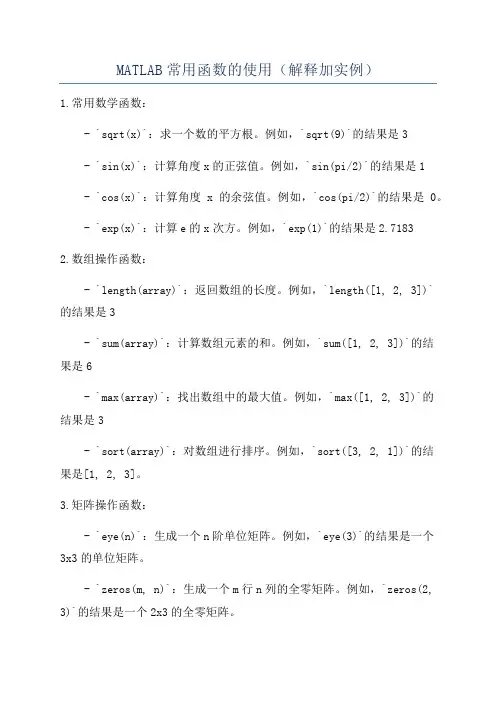
MATLAB常用函数的使用(解释加实例)1.常用数学函数:- `sqrt(x)`:求一个数的平方根。
例如,`sqrt(9)`的结果是3- `sin(x)`:计算角度x的正弦值。
例如,`sin(pi/2)`的结果是1- `cos(x)`:计算角度x的余弦值。
例如,`cos(pi/2)`的结果是0。
- `exp(x)`:计算e的x次方。
例如,`exp(1)`的结果是2.71832.数组操作函数:- `length(array)`:返回数组的长度。
例如,`length([1, 2, 3])`的结果是3- `sum(array)`:计算数组元素的和。
例如,`sum([1, 2, 3])`的结果是6- `max(array)`:找出数组中的最大值。
例如,`max([1, 2, 3])`的结果是3- `sort(array)`:对数组进行排序。
例如,`sort([3, 2, 1])`的结果是[1, 2, 3]。
3.矩阵操作函数:- `eye(n)`:生成一个n阶单位矩阵。
例如,`eye(3)`的结果是一个3x3的单位矩阵。
- `zeros(m, n)`:生成一个m行n列的全零矩阵。
例如,`zeros(2, 3)`的结果是一个2x3的全零矩阵。
- `ones(m, n)`:生成一个m行n列的全1矩阵。
例如,`ones(2, 3)`的结果是一个2x3的全1矩阵。
- `rand(m, n)`:生成一个m行n列的随机矩阵。
例如,`rand(2,3)`的结果是一个2x3的随机矩阵。
4.文件操作函数:- `load(filename)`:从文件中加载数据。
例如,`load('data.mat')`将从名为"data.mat"的文件中加载数据。
- `save(filename, data)`:将数据保存到文件中。
例如,`save('data.mat', x)`将变量x保存到名为"data.mat"的文件中。
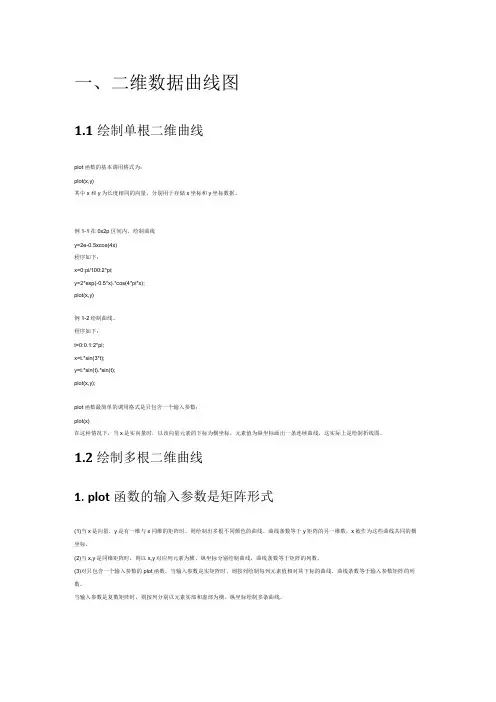
一、二维数据曲线图1.1绘制单根二维曲线plot函数的基本调用格式为:plot(x,y)其中x和y为长度相同的向量,分别用于存储x坐标和y坐标数据。
例1-1在0x2p区间内,绘制曲线y=2e-0.5xcos(4x)程序如下:x=0:pi/100:2*pi;y=2*exp(-0.5*x).*cos(4*pi*x);plot(x,y)例1-2绘制曲线。
程序如下:t=0:0.1:2*pi;x=t.*sin(3*t);y=t.*sin(t).*sin(t);plot(x,y);plot函数最简单的调用格式是只包含一个输入参数:plot(x)在这种情况下,当x是实向量时,以该向量元素的下标为横坐标,元素值为纵坐标画出一条连续曲线,这实际上是绘制折线图。
1.2绘制多根二维曲线1.plot函数的输入参数是矩阵形式(1)当x是向量,y是有一维与x同维的矩阵时,则绘制出多根不同颜色的曲线。
曲线条数等于y矩阵的另一维数,x被作为这些曲线共同的横坐标。
(2)当x,y是同维矩阵时,则以x,y对应列元素为横、纵坐标分别绘制曲线,曲线条数等于矩阵的列数。
(3)对只包含一个输入参数的plot函数,当输入参数是实矩阵时,则按列绘制每列元素值相对其下标的曲线,曲线条数等于输入参数矩阵的列数。
当输入参数是复数矩阵时,则按列分别以元素实部和虚部为横、纵坐标绘制多条曲线。
2含多个输入参数的plot函数调用格式为:plot(x1,y1,x2,y2,,xn,yn)(1)当输入参数都为向量时,x1和yl,x2和y2,,xn和yn分别组成一组向量对,每一组向量对的长度可以不同。
每一向量对可以绘制出一条曲线,这样可以在同一坐标内绘制出多条曲线。
(2)当输入参数有矩阵形式时,配对的x,y按对应列元素为横、纵坐标分别绘制曲线,曲线条数等于矩阵的列数。
例1-3分析下列程序绘制的曲线。
x1=linspace(0,2*pi,100);x2=linspace(0,3*pi,100);x3=linspace(0,4*pi,100);y1=sin(x1);y2=1+sin(x2);y3=2+sin(x3);x=[x1;x2;x3]';y=[y1;y2;y3]';plot(x,y,x1,y1-1)3.具有两个纵坐标标度的图形在MATLAB中,如果需要绘制出具有不同纵坐标标度的两个图形,可以使用plotyy绘图函数。
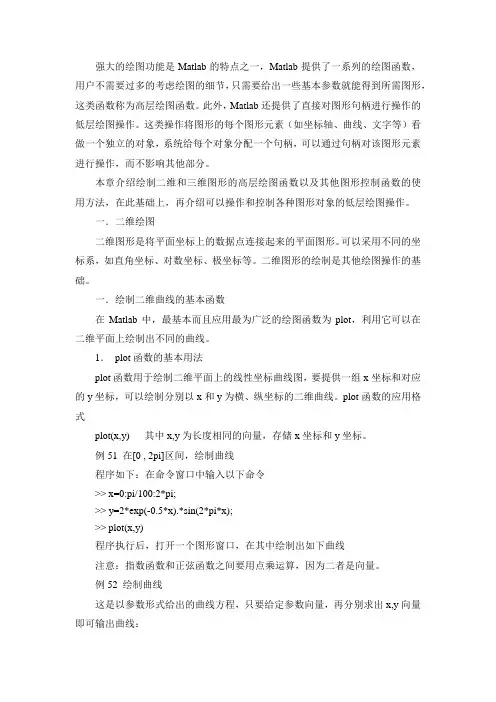
强大的绘图功能是Matlab的特点之一,Matlab提供了一系列的绘图函数,用户不需要过多的考虑绘图的细节,只需要给出一些基本参数就能得到所需图形,这类函数称为高层绘图函数。
此外,Matlab还提供了直接对图形句柄进行操作的低层绘图操作。
这类操作将图形的每个图形元素(如坐标轴、曲线、文字等)看做一个独立的对象,系统给每个对象分配一个句柄,可以通过句柄对该图形元素进行操作,而不影响其他部分。
本章介绍绘制二维和三维图形的高层绘图函数以及其他图形控制函数的使用方法,在此基础上,再介绍可以操作和控制各种图形对象的低层绘图操作。
一.二维绘图二维图形是将平面坐标上的数据点连接起来的平面图形。
可以采用不同的坐标系,如直角坐标、对数坐标、极坐标等。
二维图形的绘制是其他绘图操作的基础。
一.绘制二维曲线的基本函数在Matlab中,最基本而且应用最为广泛的绘图函数为plot,利用它可以在二维平面上绘制出不同的曲线。
1.plot函数的基本用法plot函数用于绘制二维平面上的线性坐标曲线图,要提供一组x坐标和对应的y坐标,可以绘制分别以x和y为横、纵坐标的二维曲线。
plot函数的应用格式plot(x,y) 其中x,y为长度相同的向量,存储x坐标和y坐标。
例51 在[0 , 2pi]区间,绘制曲线程序如下:在命令窗口中输入以下命令>> x=0:pi/100:2*pi;>> y=2*exp(-0.5*x).*sin(2*pi*x);>> plot(x,y)程序执行后,打开一个图形窗口,在其中绘制出如下曲线注意:指数函数和正弦函数之间要用点乘运算,因为二者是向量。
例52 绘制曲线这是以参数形式给出的曲线方程,只要给定参数向量,再分别求出x,y向量即可输出曲线:>> t=-pi:pi/100:pi;>> x=t.*cos(3*t);>> y=t.*sin(t).*sin(t);>> plot(x,y)程序执行后,打开一个图形窗口,在其中绘制出如下曲线以上提到plot函数的自变量x,y为长度相同的向量,这是最常见、最基本的用法。
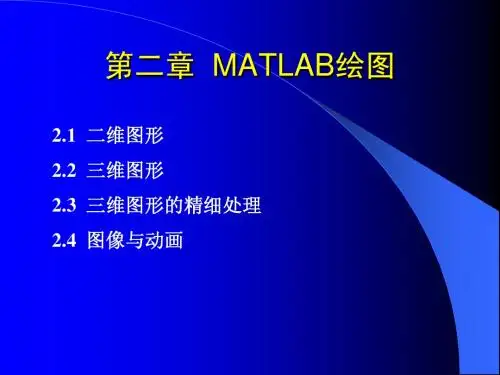

matlab中最基本的函数plot()的用法之杨若古兰创作标签: matlab plot 指令5.1 二维平面图形5.1.1 基本图形函数plot 是绘制二维图形的最基本函数,它是针对向量或矩阵的列来绘制曲线的.也就是说,使用plot 函数之前,必须首先定义好曲线上每一点的x 及y 坐标,经常使用格式为:(1)plot(x) 当x 为一贯量时,以x 元素的值为纵坐标,x 的序号为横坐标值绘制曲线.当x 为一实矩阵时,则以其序号为横坐标,按列绘制每列元素值绝对于其序号的曲线,当x 为m× n 矩阵时,就由n 条曲线.(2)plot(x,y) 以x 元素为横坐标值,y 元素为纵坐标值绘制曲线.(3)plot(x,y1,x,y2,…) 以公共的x 元素为横坐标值,以y1,y2,… 元素为纵坐标值绘制多条曲线.例5.1.1 画出一条正弦曲线和一条余弦曲线.>> x=0:pi/10:2*pi;>> y1=sin(x);>> y2=cos(x);>> plot(x,y1,x,y2)图5.1.1 函数plot 绘制的正弦曲线在绘制曲线图形时,经常采取多种色彩或线型来区分分歧的数据组,MATLAB 软件专门提供了这方面的参数选项(见表5.1.1),我们只需在每个坐标后加上相干字符串,就可实现它们的功能.- 2 -表5.1.1 绘图参数表色彩字符色彩线型字符线型格式标识表记标帜符号数据点方式标识表记标帜符号数据点方式y 黄- 实线. 点< 小于号m 紫:点线o 圆s 正方形c 青-. 点划线x 叉号d 菱形r 红- - 虚线+ 加号h 六角星g 绿* 星号p 五角星b 蓝v 向下三角形w 白^ 向上三角形k 黑> 大于号例如,在上例中输入>> plot(x,y1,'r+-',x,y2,'k*:')图5.1.2 使用分歧标识表记标帜的plot 函数绘制的正弦曲线5.1.2 图形润色MATLAB 软件为用户提供了一些特殊的图形函数,用于润色曾经绘制好的图形.函数含义grid on (/off) 给当前图形标识表记标帜添加(取消)收集xlable(‘string’) 标识表记标帜横坐标ylabel(‘string’) 标识表记标帜纵坐标title(‘string’) 给图形添加题目text(x,y,’string’) 在图形的任意地位添加说明性文本信息gtext(‘string’) 利用鼠标添加说明性文本信息axis([xmin xmax ymin ymax]) 设置坐标轴的最小最大值- 3 -例5.1.2 给例5.1.1 的图形中加入收集和标识表记标帜.(见图5.1.3 和5.1.4)>> x=0:pi/10:2*pi;>> y1=sin(x);>> y2=cos(x);>> plot(x,y1,x,y2)>> grid on>> xlabel('independent variable X')>> ylabel('Dependent Variable Y1 & Y2')>> title('Sine and Cosine Curve')>> text(1.5,0.3,'cos(x)')>> gtext('sin(x)')>> axis([0 2*pi -0.9 0.9])图5.1.3 使用了图形润色的plot 函数绘制的正弦曲线5.1.3 图形的比较显示在普通默认的情况下,MATLAB 每次使用plot 函数进行图形绘制,将从头发生一个图形窗口.但有时但愿后续的图形能够和前面所绘制的图形进行比较.普通来说有两种方法一是采取hold on(/off)命令,将新发生的图形曲线叠加到已有的图形上;二是采取subplot(m,n,k)函数,将图形窗口分隔成n m× 个子图,并选择第k 个子图作为当前图形,然后在同一个视图窗口中画出多个小图形.例5.1.3 在同一窗口中绘制线段.(见图5.1.5)>> x=0:pi/10:2*pi;>> y1=sin(x);>> y2=cos(x);>> y3=x;>> y4=log(x);>> plot(x,y1,x,y2)>> hold on>> plot(x,y3)>> plot(x,y4)>> hold off例5.1.4 在多个窗口中绘制图形.(见图5.1.6)>> x=0:pi/10:2*pi;>> y1=sin(x);>> y2=cos(x);>> y3=exp(x);>> y4=log(x);>> subplot(2,2,1);>> plot(x,y1);>> subplot(2,2,2);>> plot(x,y2);>> subplot(2,2,3);>> plot(x,y3);>> subplot(2,2,4);>> plot(x,y4);[说明] (1)子窗口的序号按行由上往下,按列从左向右编号.(2)如果不必指令clf 清除,当前图形将被绘制在子图形窗口中.图5.1.4 设置坐标轴最大最小值的正弦曲线- 5 -- 6 -5.2 三维立体图形5.2.1 三维曲线图与二维图形绝对应,MATLAB 提供了plot3 函数,可以在三维空间中绘制三维曲线,它的格式类似于plot,不过多了z 方向的数据.plot3 的调用格式为:plot3(x1,y1,z1,x2,y2,z2,...)其中x1,y1,z1,x2,y2,z2,…等分别为维数不异的向量,分别存储着曲线的三个坐标值,该函数的使用方式和plot 类似,也能够采取多种的色彩或线型(见表5.1.1)来区分分歧的数据组,只需在每组变量后面加上相干字符串即可实现该功能.例5.2.1 绘制方程x=ty=sin(t)z=cos(t)在t=[0,2*pi]上的空间方程.(见图5.2.1)>> clf>> x=0:pi/10:2*pi;>> y1=sin(x);>> y2=cos(x);>> plot3(y1,y2,x,'m:p')>> grid on>> xlabel('Dependent Variable Y1')>> ylabel('Dependent Variable Y2')>> zlabel('Independent Variable X')>> title('Sine and Cosine Curve')图5.2.1 函数plot 绘制的三维曲线图- 7 -5.2.2 三维曲面图如果要画一个三维的曲面,可以使用mesh(X,Y,Z)或surf(X,Y,Z)函数来实现.mesh 函数为数据点绘制网格线,图形中的每一个已知点和其附近的点用直线连接.surf函数和mesh 的用法类似,但它可以画出着色概况图,图形中的每一个已知点与其相邻点以平面连接.为方便测试立体绘图,MATLAB 提供了一个peaks 函数,它可以发生一个的高斯分布矩阵,其生成方程是N N ×z=3*(1-x).^2.*exp(-(x.^2)-(y+1).^2)-10*(x/5-x.^3-y.^5).*exp(-x.^2-y.^2)-1/3*exp(-(x+1).^2-y.^2)对应的图形是一个凹凸有致的曲面,包含了三个局部极大点及三个局部极小点.上面使用peaks 函数来比较一下mesh 和surf 的区别.例5.2.2 分别用mesh 函数和surf 函数绘制高斯矩阵的曲面. >> z=peaks(40);>> mesh(z);>> surf(z);图5.2.2 mesh 函数绘制的三维曲面图- 8 -图5.2.3 surf 函数绘制的着色概况图在曲面绘图中,另一个经常使用的函数是meshgrid 函数,其普通援用格式是:[X, Y]=meshgrid (x, y)其中x 和y 是向量,通过meshgrid 函数就可将x 和y 指定的区域转换成为矩阵X 和Y.如许我们在绘图时就可以先用meshgrid 函数发生在x-y 平面上的二维的网格数据,再以一组z 轴的数据对应到这个二维的网格,即可画出三维的曲面.例5.2.3 绘制方程sin((x^2+y^2)^(1/2))z = ---------------------(x^2+y^2)^(1/2)在x∈[-7.5,7.5];y∈[-7.5,7.5] 的图形.>> x=-7.5:0.5:7.5;y=x;>> [X,Y]=meshgrid(x,y);>> R=sqrt(X.^2+Y.^2)+eps;>> Z=sin(R)./R;>> surf(X,Y,Z)>> xlabel('X 轴方向')>> ylabel('Y 轴方向')>> zlabel('Z 轴方向')例 5.2.4 绘制由方程构成的立体图.(见图5.2.5)z=xe-(x^2+y^2)>> clear>> x=-2:0.1:2;y=x;>> [X,Y]=meshgrid(x,y);>> Z=X.*exp(-X.^2-Y.^2);- 9 ->> surf(X,Y,Z)- 10 -5.2.3 观察点MTALAB 答应用户设置观察点,其指令是:view(azimuth,elevation)其中方位角azimuth 是观察点和坐标原点连线在x-y 平面的投影和y 轴负方向的夹角,仰角elevation 是观察点与坐标原点的连线和x-y 平面的夹角.对于这两个角度,三维图形的默认值分别是-37.5 和30,二维图形的默认值是0 和90.例5.2.5 从分歧的角度观察高斯矩阵的曲面.>> z=peaks(40);>> subplot(2,2,1);>> mesh(z);>> subplot(2,2,2);>> mesh(z);>> view(-37.5,-30);>> subplot(2,2,3);>> mesh(z);>> view(180,0);>> subplot(2,2,4);>> mesh(z);>> view(0,90);图5.2.6 对应分歧观察点的三维曲面图5.3 其他图形函数除了plot 绘图函数之外,在有些场合对绘制的曲线会有一些特殊请求,这就要其他函数来实现,经常使用的几种函数如下(见表5.3.1)- 11 -表5.3.1 其他图形函数表函数含义loglog 使用对数坐标系绘图semilogx 横坐标为对数坐标轴,纵坐标为线性坐标轴semilogy 横坐标为线性坐标轴,纵坐标为对数坐标轴polar 绘制极坐标图fill 绘制实心图bar 绘制直方图pie 绘制饼图area 绘制面积图quiver 绘制向量场图stairs 绘制阶梯图sterm 绘制火柴杆图>> x=0:pi/10:2*pi;>> y1=sin(x);>> subplot(2,2,1);>> plot(x,y1);>> subplot(2,2,2);>> bar(x,y1);>> subplot(2,2,3);>> fill(x,y1,'g');>> subplot(2,2,4);>> stairs(x,y1,'k');图5.3.1 其他图形函数- 12 -5.3.1 直方图函数bar(x)可以绘制直方图,这对统计或者数据收集非常直观实用.它共有四种方式:bar,bar3,barh 和bar3h,其中bar 和bar3 分别用来绘制二维和三维竖直方图,barh 和bar3h 分别用来绘制二维和三维水平直方图,调用格式是:bar(x,y) 其中x 必须单调递增或递减,y 为n m× 矩阵,可视化结果为m 组,每组n 个垂直柱,也就是把y 的行画在一路,同一列的数据用不异的色彩暗示;bar(x,y,width) (或bar(y,width))指定每个直方条的宽度,如width>1,则直方条会堆叠,默认值为width=0.8;bar(…,’grouped’) 使同一组直方条紧紧靠在一路;bar(…,’stack’) 把同一组数据描述在一个直方条上.>> y=[5 3 2 9;4 7 2 7;1 5 7 3];>> subplot(2,2,1),bar(y)>> x=[5 9 11];>> subplot(2,2,2),bar3(x,y)>> subplot(2,2,3),bar(x,y,'grouped')>> subplot(2,2,4),bar(rand(2,3),.75,'stack')图5.3.2 直方图5.3.2 面积图函数area 用来绘制面积图,面积图在plot 的基础上填充x 轴和曲线之间的面积,该图用于检查某个数在该列所无数的总和中所占的比例.>> x=-3:3;>> y=[3 2 5;6 1 8;7 4 9;6 3 7;8 2 9;4 2 9;3 1 7];>> area(x,y)- 13 -图5.3.3 面积图5.3.3 饼图函数pie 用来绘制饼图,它可以抽象地暗示出向量中各元素所占比例.其调用格式是:pie(x) x 中的元素通过x/sum(x)进行归一化,以确定饼图中的份额;pie(x,explode) 向量explode 和x 元素数不异,用来指出须要分开的饼片,explode 中不为零的部分会被分开.图5.3.4 饼图- 14 -例5.3.4 设某班的某课程的考试成绩如下:90 分以上有32 人,81 至90 有58 人,71至80 分有27 人,60 至70 分为21 人,60 分以下有16 人,画出饼图.(见图5.3.4)>> x=[32 58 27 21 16];>> explode0=[1 0 0 0 0];>> subplot(1,2,1)>> pie(x,explode0)>> explode1=[0 0 0 0 1];>> subplot(1,2,2)>> pie(x,explode1)5.3.4 分歧坐标系中的绘图Semilogx,semilogy,loglo,polar(theta,rho)的使用方法和plot 完整类似,分歧的只是绘制到分歧的图形坐标上.函数semilogx 绘制x 轴为对数标度的图形,在半对数坐标系中绘图;函数semilogy 绘制y 轴为对数标度的图形;函数loglog 绘制两个轴都为对数间隔的图形;函数polar(theta,rho)绘制极坐标图形,其中theta 为相角,rho 为其对应的半径.例5.3.5 绘制ρ=acos(3θ),a=2 的图形.(见图5.3.5)>> theta=-pi:pi/80:pi;>> polar(theta,2*cos(3*theta))图5.3.5 极坐标图5.4 符号表达式绘图MATLAB 软件提供了将表达式进行图形显示的功能.完成此功能需调用fplot 函数和ezplot 函数.- 15 -函数fplot 用来绘制数学函数,其调用格式为: fplot(fun,lims)其中fun 就是所要绘制的函数,可所以定义函数的M 文件名,也能够是以x 为变量的可计算字符串.例如’diric(x,10)’或’[sin(x),cos(x)]’,对于向量x 的每个元素,函数fun(x)必须返回一个行向量.如果fun 返回[f1(x),f2(x),f3(x)],输入[x1;x2],就会返回矩阵f1(x1) f2(x1) f3(x1)f1(x2) f2(x2) f3(x2)lims=[XMIN XMAX YMIN YMAX]限制了x,y 轴上的绘图空间.>> subplot(2,2,1),fplot('humps',[0 1])>> subplot(2,2,2),fplot('abs(exp(-j*x*(0:9))*ones(10,1))',[0 2*pi]) >> subplot(2,2,3),fplot('[tan(x),sin(x),cos(x)]',2*pi*[-1 1 -1 1])>> subplot(2,2,4),fplot('sin(1./x)',[0.01 0.1],1e-3)图5.4.1 fplot 函数绘制表达式图形ezplot 函数是简捷绘图指令之一,它无需数据筹办,直接画出函数图形,基本调用格式为ezplot(f)其中f 是字符串或代表数学函数的符号表达式,只要一个符号变量,可所以x,缺省情况下x 轴的绘图区域为] 2 , 2 [ π π ? ,但我们可以用ezplot(f,xmin,xmax)或ezplot(f,[xmin,xmax])来指定x 的范围. >> y='x^2';>> subplot(1,2,1)- 16 ->> ezplot(y)>> subplot(1,2,2)>> y='sin(x)';>> ezplot(y,[-pi,pi])图5.4.2 ezplot 函数绘制表达式图形5.5 plot 函数MATLAB 对数据是按列存储和计算的,应用plot(x)时,当x 为一个向量时,以其元素为纵坐标,其序号为横坐标值绘制曲线.当x 为实矩阵时,则以其序号为横坐标,按列绘制每列元素绝对于序号的曲线,当x 为n m× 矩阵时,就有n 条曲线.如果x,y 是同维向量,plot(x,y)指令以x 元素为横坐标值,y 元素为纵坐标值绘制曲线.如x 是向量,y 是有一维与x 元素数量相等的矩阵,则以x 为共同横坐标,按列绘制y 每列元素值,曲线数为y 的另一维的元素数.如果x,y 是同维矩阵,则以x,y 对应列元素为、纵坐标分别绘制曲线,数目等于矩阵的列数.>> x=[3 5 10 8];>> subplot(2,2,1)>> plot(x)>> x=[3 5 10 8;7 2 9 4;2 7 2 7]';>> subplot(2,2,2)>> plot(x)>> x=[3 5 6 8];>> y=[1 5 10 4];- 17 ->> subplot(2,2,3)>> plot(x,y)>> x=[1 3 5 7;2 4 6 8]';>> y=[6 2 5 10;3 5 2 6]';>> subplot(2,2,4)>> plot(x,y,'k:*')5.6 交互式图形指令ginput 是一个比较特殊的图形指令,用作获取图上数据,例如指令>>[x,y]=ginput(6) % 从图形上拔取6 个点.此时,ginput 指令将把当前图形调入前台,同时光标变成十字叉,挪动光标,使交叉点落在目标点上,单击鼠标,即可获得该点数据.>> fplot('humps',[0 1])>> ginput(6)x =- 18 -y =。
【matlab基础篇03】⼀⽂带你全⾯了解plot绘图函数的使⽤(超详细+图⽂并茂)快速⼊门matlab,系统地整理⼀遍,如何你和我⼀样是⼀个新⼿,那么此⽂很适合你;⽂章⽬录1 前⾔如果你是和我⼀样的⼩⽩,强烈推荐看看这⾥,需要合理地利⽤官⽅的⽂档,通常我觉得官⽅⽂档是最好的,没有之⼀,在命令终端输⼊help plot,可以看到详细的帮助⽂档;具体如下;>> help plotplot Linear plot.plot(X,Y) plots vector Y versus vector X. If X or Y is a matrix,then the vector is plotted versus the rows or columns of the matrix,whichever line up. If X is a scalar and Y is a vector, disconnectedline objects are created and plotted as discrete points vertically atX.plot(Y) plots the columns of Y versus their index.If Y is complex, plot(Y) is equivalent to plot(real(Y),imag(Y)).In all other uses of plot, the imaginary part is ignored.Various line types, plot symbols and colors may be obtained withplot(X,Y,S) where S is a character string made from one elementfrom any or all the following 3 columns:b blue . point - solidg green o circle : dottedr red x x-mark -. dashdotc cyan + plus -- dashedm magenta * star (none) no liney yellow s squarek black d diamondw white v triangle (down)^ triangle (up)< triangle (left)> triangle (right)p pentagramh hexagramFor example, plot(X,Y,'c+:') plots a cyan dotted line with a plusat each data point; plot(X,Y,'bd') plots blue diamond at each datapoint but does not draw any line.plot(X1,Y1,S1,X2,Y2,S2,X3,Y3,S3,...) combines the plots defined bythe (X,Y,S) triples, where the X's and Y's are vectors or matricesand the S's are strings.For example, plot(X,Y,'y-',X,Y,'go') plots the data twice, with asolid yellow line interpolating green circles at the data points.The plot command, if no color is specified, makes automatic use ofthe colors specified by the axes ColorOrder property. By default,plot cycles through the colors in the ColorOrder property. Formonochrome systems, plot cycles over the axes LineStyleOrder property.Note that RGB colors in the ColorOrder property may differ fromsimilarly-named colors in the (X,Y,S) triples. For example, thesecond axes ColorOrder property is medium green with RGB [0 .5 0],while plot(X,Y,'g') plots a green line with RGB [0 1 0].If you do not specify a marker type, plot uses no marker.If you do not specify a line style, plot uses a solid line.plot(AX,...) plots into the axes with handle AX.plot returns a column vector of handles to lineseries objects, onehandle per plotted line.The X,Y pairs, or X,Y,S triples, can be followed byparameter/value pairs to specify additional propertiesof the lines. For example, plot(X,Y,'LineWidth',2,'Color',[.6 0 0])will create a plot with a dark red line width of 2 points.Examplex = -pi:pi/10:pi;y = tan(sin(x)) - sin(tan(x));plot(x,y,'--rs','LineWidth',2,...'MarkerEdgeColor','k',...'MarkerFaceColor','g',...'MarkerSize',10)与plot相关的函数还有plottools, semilogx, semilogy, loglog, plotyy, plot3, grid,title, xlabel, ylabel, axis, axes, hold, legend, subplot, scatter.2 plot2.1 显⽰正弦波显⽰⼀个简单的正弦函数;x=0:2*pi/100:2*pi;y=sin(x);plot(x,y);2.2 修改颜⾊参数颜⾊bgrcmykw下⾯修改为红⾊:x=0:2*pi/100:2*pi;y=sin(x);plot(x,y,'r');结果如下:2.3 修改点的形状参数形状图标-solido circlex x-mark+plus*stars squared diamondv triangle (down)^triangle (up)<triangle (left)>triangle (right)ppentagram h hexagram参数形状图标将点形状显⽰为六边形;x=0:2*pi/20:2*pi;y=sin(x);plot(x,y,'h','MarkerSize',10);结果如下:相关参数:MarkerEdgeColor :点边框颜⾊;MarkerFaceColor :点表⾯颜⾊;MarkerSize :点的⼤⼩;2.4 修改线的形状符号形状:dotted -.dashdot --dashedx=0:2*pi/20:2*pi;y=sin(x);plot(x,y,':','LineWidth',3);LineWidth 的参数为线宽;x=0:2*pi/20:2*pi;y=sin(x);plot(x,y,'-.','LineWidth',3);x=0:2*pi/20:2*pi;y=sin(x);plot(x,y,'--','LineWidth',3);2.5 多个参数修改下⾯修改多个参数属性显⽰⼀下正弦波;x = 0:2*pi/100:2*pi;y = sin(x);plot(x,y,'--rs','LineWidth',2,...'MarkerEdgeColor','k',...'MarkerFaceColor','g',... 'MarkerSize',10);结果如下:3 subplotsubplot 的使⽤⽅法如下:subplot Create axes in tiled positions.H = subplot(m,n,p), or subplot(mnp), breaks the Figure windowinto an m-by-n matrix of small axes, selects the p-th axes forthe current plot, and returns the axes handle. The axes arecounted along the top row of the Figure window, then the second row, etc. For example,subplot(2,1,1), PLOT(income)subplot(2,1,2), PLOT(outgo)通俗的讲:subplot(⾏,列,index)注意:plot函数要在subplot表明位置之后再调⽤。
matlab曲线绘制函数一、概述MATLAB是一款强大的数学软件,它提供了丰富的绘图功能,可以方便地绘制各种函数曲线。
本文档将介绍如何使用MATLAB绘制曲线的基本步骤和常用函数。
二、基本步骤1. 导入数据:首先需要将需要绘制的函数数据导入MATLAB中,可以使用内置函数如load或data函数从文件中导入数据。
2. 创建函数句柄:使用内置函数如fun或expression创建函数句柄,该句柄将用于表示需要绘制的函数。
3. 创建绘图对象:使用内置函数如plot或hold on创建绘图对象,该对象将用于表示绘制曲线的位置和线条样式。
4. 添加标题和标签:使用内置函数如title或xlabel添加标题和坐标轴标签。
5. 保存图像:使用saveas或print函数将图像保存到本地文件或在线展示。
三、常用函数1. plot函数:用于绘制单条曲线,可以指定线条颜色、线型和线条宽度等参数。
2. hold on函数:用于在绘图区域中连续绘制多条曲线,当前绘制的曲线将在后面绘制的曲线覆盖上。
3. plotyy函数:用于在同一图中绘制两条垂直曲线,适合绘制一对互为函数的曲线。
4. legend函数:用于添加图例,以说明每条曲线的名称和对应的数据变量。
5. xlabel和ylabel函数:用于添加坐标轴标签,以便更好地描述曲线的坐标轴范围和单位。
6. title函数:用于添加图像标题,以便更好地概括图像的主题和内容。
7. meshgrid函数:用于生成网格坐标,可以方便地计算多个坐标点的数值和点集。
四、示例代码及图像展示下面是一个简单的示例代码,用于绘制正弦曲线和余弦曲线的图像。
代码中使用了MATLAB内置的sin和cos函数,以及plot函数绘制曲线。
```matlab% 导入数据x = -pi:0.1:pi; % 定义x轴范围y_sin = sin(x); % 计算正弦值y_cos = cos(x); % 计算余弦值% 创建绘图对象并绘制曲线figure; % 创建新图像窗口plot(x, y_sin); % 绘制正弦曲线hold on; % 在当前绘图区域中继续绘制曲线plot(x, y_cos); % 绘制余弦曲线hold off; % 移除前面绘制的覆盖层,使后续曲线可见% 添加标题和标签title('正弦余弦曲线比较'); % 添加图像标题xlabel('x轴'); % 添加x轴标签ylabel('y值'); % 添加y轴标签legend('sin', 'cos'); % 添加图例,说明每条曲线的名称和对应的数据变量```运行上述代码后,将得到一幅包含正弦曲线和余弦曲线的图像,如图所示:(请在此处插入图像)通过上述示例代码和图像展示,我们可以看到MATLAB绘制曲线的基本步骤和常用函数的用法。
%plot基本绘图x=0:0.1:2*pi;y=sin(x)plot(x,y)%两个参数都是矩阵x1=0:0.1:2*pi;x2=-pi:0.1:pi;y1=sin(x)y2=cos(x)plot(x1,y1,x2,y2)%多条曲线绘制在统一坐标轴上%plot只有一个参数x=linspace(0,2*pi,200)y=sin(x)plot(y)y2=cos(x)y3=y+i*y2%横坐标实部为正弦,纵坐标虚部为余弦,构成一个圆形plot(y3)axis equal%将上述图型的横纵坐标调整为相同,使得椭圆变为正圆%plot含有多个参数x1=linspace(0,2*pi,200)x2=linspace(0,2*pi,100)x3=linspace(0,2*pi,50)y1=cos(x1)y2=sin(x2)y3=0.01*exp(x3)plot(x1,y1,x2,y2,x3,y3)%当x1,x2,x3不同维数(点数不同)可用高方法绘制%线性选项x=0:0.1:2*pi;y=sin(x)plot(x,y,'r')%颜色,g为绿色,y为黄色,k为黑色,默认b为蓝色plot(x,y,'*')%形状,*为*状,p为五角星,.为小方块plot(x,y,'--')%--为短线,:为虚线,-.为点虚线plot(x,y,'*r--')%可以组合使用,只需用一对单引号把要求全部括起来%标注x=0:0.1:2*pi;y=sin(x)plot(x,y)xlabel('x')%横坐标轴名称ylabel('y')%纵坐标轴名称title('正弦')%图名text(2,0.2,'正弦函数')%在坐标(2,0.2)处文本标注,如果同一文件下含有text.m文件,则报错%图例x1=0:0.1:2*pi;x2=-pi:0.1:pi;y1=sin(x)y2=cos(x)plot(x1,y1,x2,y2)legend('sin(x)','cos(x)')%坐标轴控制x=0:0.1:2*pi;y=sin(x)plot(x,y)xlim([0 10])%x坐标轴区间,注意此处格式为([])axis on%坐标轴显示,对应axis off不显示%原图保持x1=0:0.1:2*pi;x2=-pi:0.1:pi;y1=sin(x)y2=cos(x)hold on%图形保持,如不使用,y2将覆盖y1图形plot(x,y1)plot(x,y2)%窗口分隔x=0:0.1:2*pi;y1=sin(x)y2=cos(x)y3=tan(x)y4=exp(x)subplot(2,2,1)plot(x,y1)subplot(2,2,2)plot(x,y2)subplot(2,2,3)plot(x,y3)subplot(2,2,4)plot(x,y4)%多窗口显示x=0:0.1:2*pi;y1=sin(x)y2=cos(x)y3=tan(x)y4=exp(x)figure(1)%实现多窗口显示plot(x,y1)figure(2)plot(x,y2)figure(3)plot(x,y3)figure(4)plot(x,y4)。
MATLAB画图入门篇--各种基本图形绘制的函数与实例【来自网络】一.二维图形(Two dimensional plotting)1.基本绘图函数(Basic plotting function):Plot,semilogx,semilogy,loglog,polar,plotyy(1).单矢量绘图(single vector plotting):plot(y),矢量y的元素与y元素下标之间在线性坐标下的关系曲线。
例1:单矢量绘图y=[00.62.358.311.71517.719.420];plot(y)可以在图形中加标注和网格,例2:给例1的图形加网格和标注。
y=[00.62.358.311.71517.719.420];plot(y)title('简单绘图举例');xlabel('单元下标');ylabel('给定的矢量');grid(2).双矢量绘图(Double vector plotting):如x和y是同样长度的矢量,plot(x,y)命令将绘制y元素对应于x元素的xy曲线图。
例:双矢量绘图。
x=0:0.05:4*pi;y=sin(x);plot(x,y)(3).对数坐标绘图(ploting in logarithm coordinate):x轴对数semilogx,y轴对数semilogy,双对数loglog,例:绘制数组y的线性坐标图和三种对数坐标图。
y=[00.62.358.311.71517.719.420];subplot(2,2,1);plot(y);subplot(2,2,2);semilogx(y)subplot(2,2,3);semilogy(y);subplot(2,2,4);loglog(y)(4)极坐标绘图(Plotting in polar coordinate):polar(theta,rho)theta—角度,rho—半径例:建立简单的极坐标图形。
t=0:.01:2*pi;polar(t,sin(2*t).*cos(2*t))2.多重曲线绘图(Multiple curve plotting)(1)一组变量绘图(A group variable plotting)plot(x,y)(a)x为矢量,y为矩阵时plot(x,y)用不同的颜色绘制y矩阵中各行或列对应于x的曲线。
例1:x=0:pi/50:2*pi;y(1,:)=sin(x);y(2,:)=0.6*sin(x);y(3,:)=0.3*sin(x);plot(x,y)(b)x为矩阵,y为矢量时绘图规则与(a)的类似,只是将x中的每一行或列对应于y进行绘图。
例2:x(1,:)=0:pi/50:2*pi;x(2,:)=pi/4:pi/50:2*pi+pi/4;x(3,:)=pi/2:pi/50:2*pi+pi/2;y=sin(x(1,:));plot(x,y)(c)x和y是同样大小的矩阵时,plot(x,y)绘制y矩阵中各列对应于x各列的图形。
例3:x(:,1)=[0:pi/50:2*pi]';x(:,2)=[pi/4:pi/50:2*pi+pi/4]';x(:,3)=[pi/2:pi/50:2*pi+pi/2]';y(:,1)=sin(x(:,1));y(:,2)=0.6*sin(x(:,1));y(:,3)=0.3*sin(x(:,1));plot(x,y)这里x和y的尺寸都是101×3,所以画出每条都是101点组成的三条曲线。
如行列转置后就会画出101条曲线,每条线由三点组成。
x(1,:)=[0:pi/50:2*pi];x(2,:)=[pi/4:pi/50:2*pi+pi/4];x(3,:)=[pi/2:pi/50:2*pi+pi/2];y(1,:)=sin(x(1,:));y(2,:)=0.6*sin(x(1,:));y(3,:)=0.3*sin(x(1,:));plot(x,y)(d)如果y是矩阵,则plot(y)绘出y中各列相对于行号的图形,对于n行矩阵,x轴的坐标为[1:n]。
(2)多组变量绘图(Multiple group variables plotting):对于一系列相应的矩阵yi和xi,可以使用多组变量绘图法:plot(x1,y1,x2,y2,…,xn,yn),这种方法的优点是允许将不同大小的矩阵或矢量的图形绘制在一张图上。
例:多组变量绘图。
x=0:pi/50:2*pi;y1=sin(x);y2=0.6*sin(x);y3=0.3*sin(x);plot(x,y1,x,y2,x,y3)(3)双y轴绘图:plotyy,在一个图形窗口绘制两组数据曲线,共用一个x轴,图形两边各有一个y轴。
两条图线可以调用不同的绘图方法。
例1:x=0:0.3:12;y=exp(-0.3*x).*sin(x)+0.5;plotyy(x,y,x,y,'plot','stem')左侧y轴对应plot形式的绘图,右侧y轴对应stem形式的曲线。
例2:对于y坐标不同的情况。
t=0:900;A=1000;a=0.005;b=0.005;z1=A*exp(-a*t);z2=sin(b*t);plotyy(t,z1,t,z2,'semilogy','plot')3.图线形式和颜色(Style and color of plot)(1)图线的形式:(style of plot)MATLAB提供的四种线形,实线虚线--,冒号线:,点划线--.标记点类型:.,+,*,o,×,s(或square),d(或diamond),△,▽,<,>,p(或pentagram),h(或hexagram),plot(x,y,’—‘),plot(x1,y1,’:’,x2,y2,’*’)例1:选择不同的线形绘图。
t=0:pi/100:2*pi;y=sin(t);y2=sin(t-0.25);y3=sin(t-0.5);plot(t,y,'-',t,y2,'-',t,y3,':')例2:选择不同的标记点绘图。
t=0:pi/20:2*pi;x=t.^3;y=sin(t);plot(x,y,'o')(2)线的颜色(color of plot):MATLAB中可选的颜色:红r,绿g,蓝b,黄y,粉红m,青c(cyan)黑k.例:t=0:pi/20:2*pi;y=sin(t);plot(x,y,'r'),plot(x,y,'g+')(3)图线的其他属性(other characters of plot):可设置图线的宽度、标记点的边缘颜色、填充颜色、标记点的大小等。
例:设置图线的线形、颜色、宽度、标记点的颜色及大小。
t=0:pi/20:pi;y=sin(4*t).*sin(t)/2;plot(t,y,'-bs','LineWidth',2,'MarkerEdgeColor','k','MarkerFaceColor','y','MarkerSize',10)4.复数绘图(Complex plotting):plot用于函数绘制复数的图形时,通常虚部是被忽略的。
但plot只作用于单个复变量z 时,则绘出的是实部对虚部的关系图(复平面上的一组点)。
即这时plot(z)等价于plot(real(z)).例:画一个20边的多边形(用exp函数生成),顶角用小圆圈表示。
t=0:pi/10:2*pi;plot(exp(i*t),'o');axis('square')如果在复平面绘制多重线,只能分别以实部和虚部为坐标来绘制,否则虚部将被忽略,并给出警告。
二.图形的控制与表现(Figure control and representation)MATLAB提供的用于图形控制的函数和命令:axis:人工选择坐标轴尺寸.clf:清图形窗口.ginput:利用鼠标的十字准线输入.hold:保持图形.shg:显示图形窗口.subplot:将图形窗口分成N块子窗口。
1.图形窗口(figure window)(1).图形窗口的创建和选择(Creating and selecting of figure window)figure(n)函数用于为当前的绘图创建图形窗口,每运行一次figure就会创建一个新的图形窗口,n表示第个n窗口,如果窗口定义了句柄,也可以用figure(h)将句柄h的窗口作为当前窗口。
clf命令用于清除当前图形窗口中的内容。
shg命令用于显示当前图形窗口。
(2).在一个图形窗口中绘制多个子图形(Drawing several subfigures in a single window)subplot(m,n,p),把窗口分成m×n个小窗口,并把第p个窗口当作当前窗口。
例:将4个图形显示在同一个图形窗口中。
t=0:pi/20:2*pi;[x,y]=meshgrid(t);subplot(2,2,1);plot(sin(t),cos(t));axis equalsubplot(2,2,2);z=sin(x)+cos(y);plot(t,z);axis([02*pi–22])subplot(2,2,3);z=sin(x).*cos(y);plot(t,z);axis([02*pi–11])subplot(2,2,4);z=sin(x).^2-cos(y).^2;plot(t,z);axis([02*pi–11])(3).在一个已有的图形上绘图(Drawing a figure on the figure was existed):用hold on命令在一个已有的图形上继续绘图,使用hold off命令结束继续绘图。
例:将peaks函数的等高线图与伪彩色画在一起。
[x,y,z]=peaks;%产生双变量数组contour(x,y,z,20,'k')%绘制等高线hold onpcolor(x,y,z)%绘制伪彩色图shading interp%表面色彩渲染hold off2.坐标轴控制命令(Axis control commands)控制坐标性质的axis函数的多种调用格式:axis(xmin xmax ymin ymax):指定二维图形x和y轴的刻度范围,axis auto设置坐标轴为自动刻度(缺省值)axis manual(或axis(axis))保持刻度不随数据的大小而变化axis tight以数据的大小为坐标轴的范围axis ij设置坐标轴的原点在左上角,i为纵坐标,j为横坐标axis xy使坐标轴回到直角坐标系axis equal使坐标轴刻度增量相同axis square使各坐标轴长度相同,但刻度增量未必相同axis normal自动调节轴与数据的外表比例,使其他设置失效axis off使坐标轴消隐axis on显现坐标轴(1)坐标轴的范围(Domain of coordinates axis):二维图形坐标轴范围在缺省状态下是根据数据的大小自动设置的,如欲改变,可利用axis(xmin xmax ymin ymax),函数来定义。